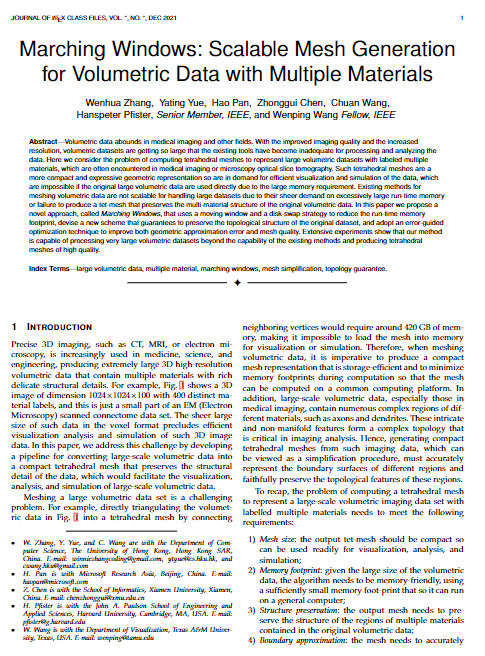| Marching Windows: Scalable Mesh Generation for Volumetric Data with Multiple Materials |
| Wenhua Zhang1, Yating Yue1, Hao Pan2, Zhonggui Chen3, Chuan Wang1, Hanspeter Pfister4, Wenping Wang#1,5 |
| 1The University of Hong Kong, 2Microsoft Research Asia, 3Xiamen University, 4Harvard John A. Paulson Scool of Engineering and Applied Sciences, 5Texas A&M University, |
| |
 |
|
Simplification results of the teeth dataset with different target edge variances. (a) With target edge variance of 3, the result keeps around 0.98% of original vertices. (b) With target edge variance of 5, the result keeps around 0.62% of original vertices. (c) With target edge variance of 10, the result keeps around 0.42% of original vertices. Smaller target edge variance leads to denser output mesh with higher mesh quality. Geometric features are also better preserved with smaller target edge variance.
|
| Data |
|
|
| Code |
 |
|
[Github page]
[Docker] (Coming Soon)
Citation:
Zhang W., Yue Y., Pan H., Chen Z., Wang C., Hanspeter P.& Wang, W. (2022). Marching Windows: Scalable Mesh Generation for Volumetric Data with Multiple Materials. IEEE Transactions on Visualization and Computer Graphics.
|
|
| Abstract |
|
Volumetric data abounds in medical imaging and other fields. With the improved imaging quality and the increased resolution, volumetric datasets are getting so large that the existing tools have become inadequate for processing and analyzing the data. Here we consider the problem of computing tetrahedral meshes to represent large volumetric datasets with labeled multiple materials, which are often encountered in medical imaging or microscopy optical slice tomography. Such tetrahedral meshes are a more compact and expressive geometric representation so are in demand for efficient visualization and simulation of the data, which are impossible if the original large volumetric data are used directly due to the large memory requirement. Existing methods for meshing volumetric data are not scalable for handling large datasets due to their sheer demand on excessively large run-time memory or failure to produce a tet-mesh that preserves the multi-material structure of the original volumetric data. In this paper we propose a novel approach, called Marching Windows, that uses a moving window and a disk-swap strategy to reduce the run-time memory footprint, devise a new scheme that guarantees to preserve the topological structure of the original dataset, and adopt an error-guided optimization technique to improve both geometric approximation error and mesh quality. Extensive experiments show that our method is capable of processing very large volumetric datasets beyond the capability of the existing methods and producing tetrahedral meshes of high quality. |
| |
| Network Overview |
 |
|
Overview of the pipeline. Following the marching windows approach (Sec. 4), inside each window, (a) we first generate an initial mesh from the bounded input image stack (Sec. 5.1), (b) then simplify it to reduce data size and produce a quality mesh with geometric fidelity (Sec. 5.2, 5.3, and 5.4), and (c) apply CODT iterations to further improve the mesh quality (Sec. 5.5). Both simplification and CODT optimization are guaranteed to preserve material subdomain topology. We show cut-off views of the tetrahedral meshes to better illustrate the mesh improvements.
|
| |
| ©Wenhua Zhang. Last update: Dec., 2022. |


